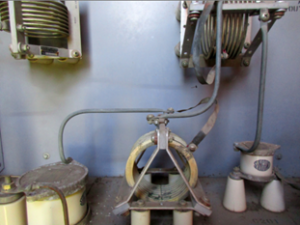Making Better AM Transmissions

[October 2023] We have seen a lot of attention lately to AM radios in vehicles. Yes, there are issues with RFI of various sorts. But are stations sending out the best audio possible? For the technical folks who are mostly experienced in FM, AM is sometimes a mystery as to how to get the most out at the antenna. Ron Schacht has some pointers picked up over the years to share.
As we all know, AM radio is and has been bashed, ignored, knocked around, and abused for several years now.
The medium that has pretty much saved the world and millions of lives over the years has been thrown in the garbage with old bottles, cans, end the like. Now, we have an entire generation who does not know what broadcast radio is let alone old scratchy AM – they are addicted to their phones.
Well, like the vinyl LP which is enjoying a comeback, I think AM radio can do likewise if its nurtured.
WHEN AM LOST ITS LEAD
I have always felt that the fidelity, mono, and noise were not the main reason for AM radios demise – it was programming.
AM was Big Time as we worked our way into the 70s. But, then, an alternative appeared to four songs per hour and 50 minutes of commercials all of it compressed to within a tenth of a dB and as distorted as all get out. FM started playing rock – not only top 40 but soft rock, hard rock, and psychedelic rock – 55 minutes an hour with little compression, few commercials, and sounding just like the vinyl you brought home.
It is no wonder AM was left in the dirt.
CAN AM GET BACK ON TOP?
The trick now is to do the same thing with AM.
If you tune around the FM dial, it is reminiscent of AM back then, cookie cutter 40-song playlists, more commercials than music, over-processed audio (someday managers will realize unlike on AM, loudness on FM does not increase ERP). I think that it is time for the AM guys to come up with some original programs, not just plug in a satellite receiver to some talk shows, presented in an appealing way to listeners.
Some guys are doing it now because of the FM translators but I never hear them saying KKKK 1350AM and 99.5 FM – they virtually never mention the AM frequency at all.
Here in the upper Midwest where it is flat and ground conductivity is great, an AM signal goes for a hundred miles or better, while the FM gets maybe thirty-five. So, we make our money on the big AM signals. We ID the stations and actually use the AM slogan and only mention the FM frequency on occasion, like when we have to ID the translator.
PROGRAMMING IS NOT EVERYTHING
At the same time, if we solve the programming issues, we need to make sure technically we have the best, cleanest sound possible on the AM signal.
It is my experience that it takes real broadcast engineers to make the technical side of AM work well – and thus it seems smart to discuss AM antenna tuning and AM fidelity.
In many ways, here is where a real true broadcast engineer comes into the act. FM for the most part is plug and play. Just about anyone with any knowledge of electronics can build an FM station from the ground up. Buy the bits and pieces, run the necessary wires, get someone to put AC power to the transmitter, get a tower crew to put up the antenna and connect the coax to the transmitter and you are on-the-air and, unless someone screwed up, sounding really good.
I am hoping the guys who have been raised on FM and now have fallen into an AM acquisition might be able to learn a little bit.
HORSE OF A DIFFERENT COLOR
The relative ease of FM construction is not the same with AM, because once you get nice clean audio to the transmitter, the real engineering begins, so you can get it out into the ether.
For the sake of discussion, let us start by figuring you have a standard quarter-wave series-fed antenna.
It does not have to be exactly this, but we can use a quarter-wave antenna to get started. In addition to the tower, it is important to have a good standard ground system.
FATTER IS BETTER
First things first. Whenever you have the option, remember “the fatter the tower, the fatter the signal!”
Why?
It is hard to get 20 kHz bandwidth from a 12-inch face tower – especially as you go down the dial.
The percentage of bandwidth required as you lower the frequency changes. Let us say you are at 600 kHz. 20 kHz out of 600 kHz is 3.3 % whereas 20 kHz out of 1500 is only 1.3 % so it is easier to squeeze a 20 kHz bandwidth (and this is a minimum number) through a pipe when it is using 1.3 % of the pipe than when it is using 3.3% .
Thus, you guys up at the top of the band actually have an easier job, considering everything else equal. However, even if you are unlucky enough to have a facility on 540 kHz with a 12-inch face tower, you are not “sunk” – you can always put a skirt on the tower and run it as a folded unipole or just use the skirt to “fatten” the tower.
SETTING THE DRIVE POINT
If you have a VNA – or one of those other fancy devices – you can pull this off pretty easily – just use the device to look at the antenna and see what you have +/- at least 20 kHz on either side of your carrier.
Generally, as you go below the carrier the resistance will go down and the reactance will go up and vice versa as you go above the carrier (remember: we are positing a 1/4 wave tower). The idea now is to produce a matching network that will present a good load to the transmitter, at the transmitter, not at the ATU input. (Many solid-state transmitters balk if you try to load them much away from 50 Ohms and j0.)
Since there will be phase shifts in the transmission line depending on how long it is, what you have at the ATU is usually inconsequential to the load at the transmitter output. Personally, maybe because I am an old fart, I prefer my old GR bridge, maybe because it is easier for old eyes to see or it is just because I have done it this way for 60 years and it works.
Here is the trap: adding or removing capacitors and or inductors in the ATU in an effort to make an ideal 50 Ohms (assuming that is the line and transmitter parameters) and j0 at any point +/- 20kHz from your carrier. In the real world this might take about five networks, which, by then, you will have enough phase shifts and losses to destroy it all, not a practical goal.
THE “T” NETWORK
With a simple T network, you can come up with a good compromise at the ATU, which is what I usually do.

For example, I aim for 50 Ohms at carrier and a slightly lower resistance on the sidebands, say 45 Ohms at +/- 20 kHz. Now, we want as little reactance as possible – but we will have some no matter what. So, I aim for “equal and opposite” say j10 at one sideband (20 kHz) and -j10 at the other sideband.
If you can achieve this at the transmitter, you will enhance your high end in the field because with lower resistance in the sidebands the transmitter will deliver more antenna current there, consequently more power where radios roll off.
To do all this right takes time, and if your ATU is 500 feet from your transmitter, unless you are a daily jogger, will need two people: a grunt to change taps and capacitors and an engineer to operate the bridge or VNA back in the shack.
A TUNING CLUE FROM THE OLD DAYS
We used to carry it even farther in the days of vacuum tube transmitters.
The transmitter performance is really the load at the output of the final output device(s) be they tubes or transistors. Since high impedance bridges were hard to come by. We could calculate the plate impedance of the output tubes – say for a kilowatt – a pair of 4-400A’s which ran at 2500 Volts at 500 mA.
That would make a plate load of 5000 Ohms. We would substitute a 5000 Ohm carbon resistor for the tubes (transmitter off of course) and look back into the output of the transmitter with our GR bridge. Then you could set the transmitter output network so the network was flat looking at it in reverse so the tubes themselves with the antenna connected were as happy as a clam seeing a very nearly perfect load at carrier and 30 kHz wide.
Unfortunately, this did not always work as planned because some transmitter manufacturers did not necessarily worry about the Q of their networks so you might have to get into the output network and rework the LC ratios to get it to work.
NOT QUARTERWAVE?
Now, if your antenna is not quarter wave, if it is a grounded unipole or a self-support “Eiffel Tower”, with an inexpensive isocoupler – the parallel-resonant type rather than the coupled loops – all bets are off as to what it will do as far as resistance and reactance go.
You still can calculate the network values if you know the plot of the antenna Z and the transmitter/line characteristics. There are several good books where you can get the math which is too deep to cover here but “Radio Antenna Engineering” by LaPorte or a book put out several years ago “Directional Antennas Made Simple” by Jack Layton are good ones. Jack’s book gives you matching networks even if you are a non-DA operation. There are several others but those two come to mind.
BUILDING THE NETWORK
If you do not want to calculate it yourself: do, or have a consultant do a sweep on your antenna from 30 kHz below to 30 kHz above.
If you have a VNA you can probably run a sweep just looking at 60 kHz bandwidth with your carrier in the middle and send him the picture of the display.
With this information a consultant or a company who manufactures ATU’s knowing this, as well as your transmission line type and length, can design and or build you a tuner that will be close to plug and play. For optimal performance though, even with a plug and play tuner, you should measure the results at the transmitter output.
I hope you can use a couple of these tips to make your AM sound great and then get management to remember it exists and do something saleable with it rather than let it be there because it “has to” in order to satisfy the Commission translator rules.
– – –
Ron Schacht (K3FUT) is a contract engineer in South Dakota. Over the last 60 years he has built some 100 stations, including a dozen with directional antennas. You can connect with Ron at ron.kq1380@nvc.net
– – –
Would you like to know when more articles like this are published? It will take only 30 seconds to
click here and add your name to our secure one-time-a-week Newsletter list.
Your address is never given out to anyone.
– – –
